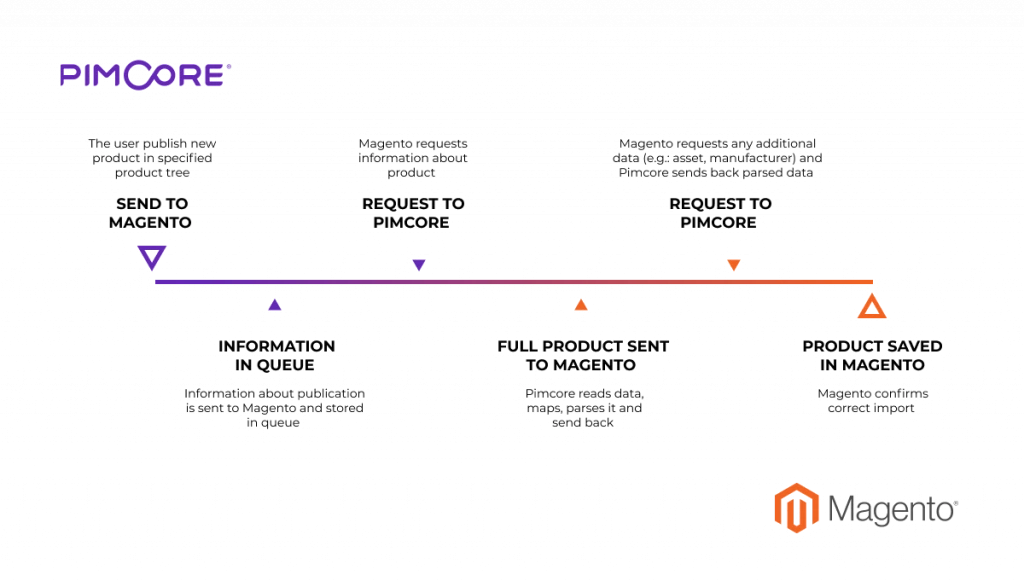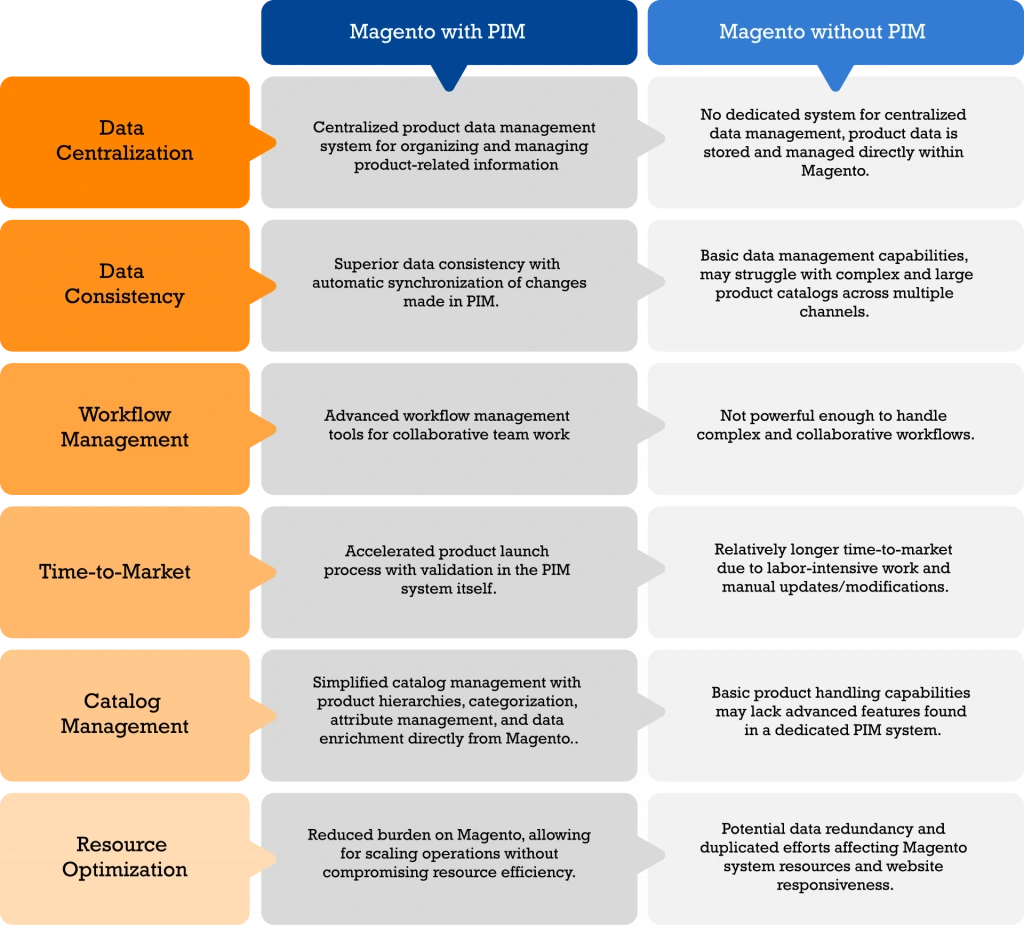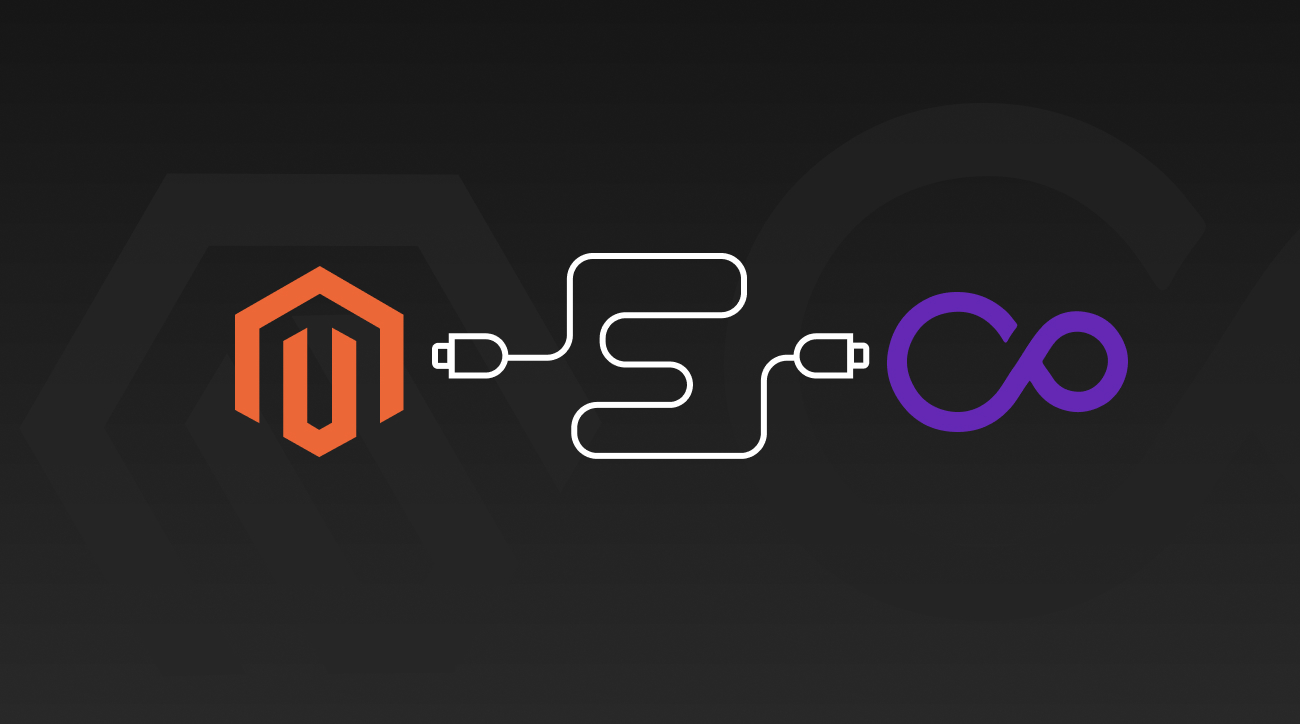Is your Magento store struggling to manage large volumes of product data across multiple SKUs? Or is your workflow totally cluttered making it difficult for you to maintain omnichannel consistency?
If this is the case, integrating your Magento store with a PIM (Product Information Management) system could be the perfect solution to streamline your product data and workflow.
Here’s a case study depicting how we enabled Pimcore Magento 2 integration for two of our prominent clients, MomStore and Carter’s. Explore how we transformed their customer experiences and digital presence through effective catalog management. Plus, gain valuable insights on
- Why do you need a PIM Solution?
- How to integrate Pimcore and Magento 2?
- What are the challenges associated with the implementation?
- Difference between having Magento with PIM and without PIM?
- How does Pimcore integration help in improving Digital Commerce?
Why do you need a PIM Solution?
PIM (Product Information Management) solution enables you to manage, store and enrich all your product data from a single master data repository. It streamlines the entire process of product data and catalog management, resulting in a highly efficient and scalable solution. With its unique capabilities for data enrichment, you can ensure superior data quality, enhanced team collaborations, and optimized workflow management, all while accommodating your growing business needs.
Now, you might be thinking why do you need PIM when you have Magento?
Magento (Adobe Commerce) as a stand-alone platform is in itself highly efficient. However, when it is integrated with Pimcore’s powerful PIM System, you can observe a remarkable boost in your website capabilities. While both platforms have their own unique set of features, Pim provides you with an advanced level of control over your product data, workflow management, and omnichannel commerce. In addition, if your business has multiple sales channels, such as offline stores (apart from Magento online store), PIM can serve as the master data for all sales channels, ensuring seamless and accurate catalog updates.
Let’s take a closer look at this concept and make it easier to understand!
Imagine a single, user-friendly hub that syncs every vital element of your business seamlessly such as product data, marketing content, teamwork, and customer experience. Your business can achieve perfect harmony and better control over your operations, right?
And, that’s exactly what you can achieve with Pimcore Magento 2 integration. It helps you create a centralized data management system by combining the capabilities of Pimcore’s flexible Product Information Management (PIM) system with the powerful eCommerce features of Magento.
So, if you are facing trouble with any of these, try integrating your store with PIM
- Manage large catalog with sizes typically exceeding 15000 items.
- Manage multiple SKUs.
- Ensure automated removal of inconsistent and obsolete data
- Integrate different marketplaces to provide unified product offerings.
- Streamline workflows and boost employee productivity
In a nutshell, Pimcore Magento 2 integration offers you an all-in-one solution that can effortlessly adapt to your evolving business requirements, ultimately improving customer experiences and changing the way they interact with your brand.
Now, the question is:
How to integrate Pimcore with a Magento eCommerce store?
MomStore, a leading brand specializing in mom and baby products, wanted to launch a fresh system ensuring compatibility with Pimcore to simplify their data management process. Meanwhile, Carter’s, a renowned kidswear brand, wanted to expand their system capabilities by supporting an additional website catering to the UAE market.
Though both MomStore and Carter’s already had a Magento website, the reason why they wanted Pimcore was due to their store’s requirement to have a scalable solution capable of handling huge catalog sizes. Plus, their systems were not delivering optimal performance, which was again drastically affecting their sales.
Codilar, being a leading solution expert, was approached by our clients in this regard. Our team of experienced Pimcore developers understood their problem statements and provided customized solutions according to their requirements. We helped them seamlessly transform their eCommerce experiences with Pimcore Magento 2 integration.
Let’s walk you through the step-by-step process of how we implemented Pimcore for MomStore and Carter’s.
1. Integration of Pimcore and Enterprise Resource Planning (ERP)
First, we begin with the installation of the Pimcore system, where the ERP system of the organization integrates with it using GraphQL APIs. These two systems collaborate to complement each other’s features. It enriches your back-end and front-end functionalities, making it the perfect system fulfilling your marketing and sales needs.
2. Installation of the Pimcore Magento 2 Connector
Both Pimcore and Magento have different database structures with unique APIs. To carry out the integration between these two systems, we have to install the Pimcore Magento 2 connector, an open-source module provided by Divante.
The connector extension has two modules, one integrates the bundle on the Pimcore end while the other integrates the bundle on the Magneto end. But, the condition here to enable the connector to establish integration is that the two systems should be compatible.
For Momstore and Carter’s, we have used Pimcore Open Source edition to integrate into their Magento 2 enterprise edition. Initially, the systems were incompatible due to differences in the editions. However, we made necessary modifications to the connector to make it compatible with one another.
3. Configuring the Pim Magento connector
After installation, the connector is configured to further integrate Pimcore with Magento. This is done by generating authorization tokens from the Magento admin panel via standard API protocols. These tokens are then saved on the Pimcore system which checks and validates Magento APIs to process the integration.
Here, we ensured to customize the connector’s settings, including API endpoints, authentication parameters, and event triggers to establish a seamless connection between Pimcore and Magento.
4. Synchronizing the contents between Magento and Pimcore.
Before mapping the product data from Pimcore to Magento, we have to set the rules for data synchronization between them.
We organized the product structure and finalized the product schema on Pimcore. Followed by establishing triggers and events to initiate data synchronization, such as product creation, updation, or deletion. It includes product attributes such as product details, assets, and taxonomies defining single products, configurable products, and bundle products.
We developed and deployed innovative queuing mechanisms and bundle product support in Pimcore to swiftly carry out batch processing of product updates, which significantly simplified the entire process of catalog management
5. Mapping content between Pimcore and Magento
Whenever a class of data objects is created or updated on Pimcore, we have to publish it. Subsequently, the information is sent to Magento saying a new product data is available.
For our clients, we created cron jobs in Magento to make the process of fetching data from Pimcore much faster. These cron jobs are operations running in the background which automates certain commands to be executed at regular intervals. These commands call the Pimcore’s API to gather details about the new product data to instantly update or create the new product in Magento.

Hence, these are the implementation steps we followed to integrate Pimcore and Magento. Check out the transformational experience of MomStore and Carter’s, after the integration.
How to overcome the challenges in Pimcore Magento implementation?
Integrating Pimcore with Magento can greatly enhance your business capabilities, but it’s not devoid of challenges which needs to be addressed promptly to avoid affecting your business in any way.
We have listed down some of the most common challenges we faced during the implementation process. Here’s how we approached these challenges and resolved them in no time.
Data Mapping and Synchronization:
Pimcore and Magento have different data structures, so mapping and synchronizing data between the two systems can be challenging. To address this, we
- Performed a detailed analysis of data models in both systems.
- Implemented custom mapping rules and data synchronization processes to ensure that product information, categories, attributes, and other data remain consistent and up-to-date.
Extension Compatibility:
Pimcore and Magento both support extensions and modules, but compatibility issues can arise when integrating them. To address this,
- Carefully review and test the compatibility of extensions used in both systems.
- Modify or develop custom extensions to ensure seamless compatibility.
System Performance:
Integrating Pimcore and Magento can impact system performance, as both platforms are resource-intensive. To address this performance optimization techniques should be employed which includes
- Optimizing database queries
- Enabling caching mechanisms
- Ensuring sufficient server resources are allocated to handle the integrated system’s workload.
User Experience:
Creating a unified and seamless user experience between Pimcore and Magento is essential. To address this challenge
- The user interfaces of both systems should be carefully integrated.
- Customize the user interface to maintain consistency in branding, navigation, and user workflows.
- Perform user acceptance testing and feedback gathering to help identify areas for improvement and ensure a smooth user experience.
Security:
Integrating Pimcore and Magento requires attention to security considerations. Steps should be taken to ensure secure data transmission between the systems,
- Implement proper user access controls
- Follow security best practices such as using encrypted connections and regularly updating security patches and versions.
Testing and QA:
Thorough testing is crucial to identify and address any integration issues. This includes
- Functional testing to ensure that data is correctly synchronized.
- Performance testing to evaluate system response times and scalability.
- User acceptance testing to validate the integrated system’s usability and effectiveness.
- Implementing a well-defined testing strategy powered by automated testing tools to streamline the process.
Documentation and Training:
Comprehensive documentation and training materials should be created to support users in understanding and utilizing the integrated system effectively.
- This can include user guides, system documentation, and training sessions tailored to the specific requirements of the integrated Pimcore-Magento solution.
At Codilar, our expertise lies in tackling these challenges. In fact, our exceptional service and out-of-the-box solution for MomStore has helped us emerge as one of the top three finalists for the prestigious Pimcore Data Hero The Year 2022 Award.
What is the difference between having Magento with PIM and without PIM?
Here is the key differences between having Magento with a PIM (Product Information Management) system and without a PIM:

How does Pimcore integration help in improving Digital Commerce?
The eCommerce sector is constantly evolving and shaping the future of shopping. With new technologies, logistics capabilities, and evolving customer demands, it is imperative that you adopt the right tools and technologies to stand out from the competition.
Here’s how Pimcore integration can boost your digital commerce
Data Accuracy:
By leveraging Pimcore’s data cleansing, enrichment, and validation tools, brands can enhance their product data significantly, including descriptions, assets, and flexible taxonomy. This means that any updates made in Pimcore are instantly reflected in Magento, ensuring consistency across various sales channels. Also, identifying duplicate product pages and errors has become much simpler, making the system more autonomous, requiring minimal human supervision.
Robust APIs:
It is capable of seamlessly integrating with any third-party software to manage data, assets, documents, versions, permissions and security controls, enabling you to build custom solutions based on your unique needs.
Better traceability:
With real-time data monitoring and integrated dashboard features, customers can easily find the desired products and purchase them. It also tracks the entire product lifecycle, updates and publishes product descriptions, streamlines orders and provides better product analytics, thus improving traceability and customer experience.
Marketplace integration:
With Pimcore you can integrate and manage multiple marketplaces from a single instance and provide consistent content management services throughout.
Omnichannel Consistency:
Magento 2 integration enables your business to produce up-to-date product information while maintaining consistency across multiple sales channels by integrating ERPs, CRMs, eCommerce platforms, and marketplaces.
Product Personalization:
Based on the characteristics of the target customer segments, your business can offer personalized product recommendations or create diverse catalogs matching their unique needs across multiple sales channels.
Improved productivity:
PIM enables your business to streamline workflow and improve employee productivity. It seamlessly integrates with your CRM and other data management systems to retrieve, update and publish data on your websites. Besides, most of the manual tasks are automated with respect to certain rules, thus eliminating the time required for verification and publishing.
Conclusion
In conclusion, the implementation of Pimcore and Magento integration has proven to be a game-changer, for both MomStore and Carter’s. Our team could observe visible transformation in their digital commerce experience. The integration not only simplified their catalog management but also helped in enhancing operational efficiency, reducing manual efforts, and ensuring data consistency across multiple systems. It has empowered them to deliver exceptional customer experiences, drive sales, and improve overall revenue.
If you also want to help your business resolve issues related to extensive data processing, get in touch with our Certified Pimcore developers.










